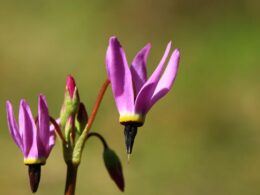Bloodflower: A Bloom Well Liked by Butterflies
The plant gets its name from its colorful blooms, which range in shade from deep red to bright orange, which are beloved by butterflies. The vivid red and orange hue of its petals is a striking contrast to the green of its leaves. The bloodflower, is a tropical and subtropical flower, a native plant of North and South America, but it can also be found in parts of Europe and Asia. The Mexican butterfly weed is also known as the blood flower, due to the red sap that flows from its stems.
The flowers are rich in nectar, and they bloom throughout the summer months, providing a vital food source for butterflies. In addition to being a food source, the bloodflower is also an important host plant for many species of butterflies. The leaves of the plant provide shelter and protection for butterfly eggs and caterpillars. As a result, the bloodflower plays a critical role in the life cycle of many butterfly species. Butterflies are not the only creatures that appreciate the bloodflower; hummingbirds, bees, and even some types of birds enjoy its nectar as well.
Sunset Flower: Taking Care of the Blood Flower Asclepias
If you’re interested in growing Mexican butterfly weed, it’s easy to do so from seed. Once you have your seeds, simply plant them in well-drained soil and water them regularly. The plants will typically bloom within a few months.
The blood flower is a beautiful plant that can add a touch of drama to any garden. However, it is also a bit of a diva when it comes to care. Here are a few tips on how to grow a healthy blood flower:
- Plant in well-drained soil in full sun (they prefer full sun, but can tolerate partial shade).
- They need well-drained soil and should be watered regularly, especially during hot weather.
- Blood flower milkweed should be fertilized monthly during the growing season with a balanced fertilizer.
- They need to be pruned back after blooming to encourage new growth.
In conclusion, blood flower grows best in full sun and sandy soil, and it blooms from late summer to late fall (they may also grow as an annual). Although the bloodflower is not commonly cultivated, it can be a beautiful addition to any garden.
Milkweed Seeds
The tropical milkweed plant is an important food source for many species of butterflies, including the bloodflower (the monarch). The milkweed’s Latin name, actually comes from the Greek god of healing, Asclepias. This is because milkweed was used historically as a medicinal herb to treat a variety of ailments.
The milkweed plant contains a toxic sap that makes it unpalatable to most animals. However, the monarch butterfly has evolved to be able to eat milkweed without being harmed by the sap. In fact, the toxic chemicals in milkweed actually make the monarch more poisonous to predators.
The bright orange and black colors of the monarch’s wings serve as a warning to would-be predators that the butterfly is poisonous. Orange-red flowers are also the host plants for the milkweed hawk moth caterpillar. The caterpillar eats the milkweed leaves and stores the toxins in its own body, making it poisonous to predators as well.
Milkweed Characteristics
Milkweed seeds are small and delicate, with a silky exterior that is easy to damage. The seeds are also covered in a sticky substance that can be difficult to remove. Blood flowers, on the other hand, have larger seeds that are encased in a hard shell. The seeds of a blood flower are also easier to remove from the plant. As a result, milkweed seeds are more difficult to collect than blood flower seeds. However, milkweed seeds are an important food source for many animals, so it is worth the effort to collect them.
The Dangers of the Bloodflower
This plant is native to Mexico, but it can be grown in other parts of the world. It’s a member of the milkweed family, and like other native milkweed species, it’s poisonous to animals if they eat too much of it. The monarch blood flower is a beautiful, but deadly, plant. The monarch butterfly is attracted to the flowers by their bright red color. Once the butterfly lands on the flower, however, it becomes trapped. The monarch cannot escape and will eventually die. While the monarch blood flower may be beautiful, it is important to remember that it is also dangerous.
Blood Flowers and Your Health
The blood flower is a dangerous plant that can cause serious health problems in humans and animals. Be careful, because flowers in addition to being very beautiful, they contain a poisonous substance that can make people sick. A toxic substance can cause for example vomiting, diarrhea, and even death. If you touch the flower, the poison can enter your bloodstream and cause dangerous side effects. If you are exposed to the poison, you should seek medical help immediately.
An Invasive Plant
In addition, the blood flower is known to be invasive, meaning it can spread quickly and take over an area. This makes it especially dangerous to people who live in areas where the plant is found. The best way to avoid the dangers of the blood flower is to stay away from areas where the plant is known to grow. If you come into contact with the plant, be sure to wash your hands and clothes thoroughly.
The blood flower is dangerous, but it is also very beautiful. If you see one, you should admire it from a distance. With a little care, you can enjoy the beauty of the blood flower for many seasons to come. They can easily be grown in most gardens.



















